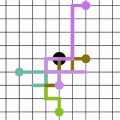In this paper we introduce and study the \textsc{StreamingCycles} problem, a random order streaming version of the Boolean Hidden Hypermatching problem that has been instrumental in streaming lower bounds over the past decade. In this problem the edges of a graph $G$, comprising $n/\ell$ disjoint length-$\ell$ cycles on $n$ vertices, are partitioned randomly among $n$ players. Every edge is annotated with an independent uniformly random bit, and the players' task is to output the parity of some cycle in $G$ after one round of sequential communication. Our main result is an $\ell^{\Omega(\ell)}$ lower bound on the communication complexity of \textsc{StreamingCycles}, which is tight up to constant factors in $\ell$. Applications of our lower bound for \textsc{StreamingCycles} include an essentially tight lower bound for component collection in (almost) random order graph streams, making progress towards a conjecture of Peng and Sohler [SODA'18] and the first exponential space lower bounds for random walk generation.
翻译:在本文中,我们介绍并研究“Textsc{StreamingCylecles} ” 问题,这是在过去十年中推动下线流动的布林隐藏超配问题随机顺序流版。在这个问题中,由美元和美元等值组成的美元平方块的边际,在美元垂直值上随机分割。每个边缘都有独立的单一随机点附加说明,而玩家的任务是在连续通信一回合后以G美元输出某个周期的等值。我们的主要结果为$\ell\ ⁇ Omega(ell)}美元,在\ textsc{StreamingCycle} 的通信复杂性方面,美元G$的边际小于$/ ell$/\ ell美元,与美元等值常数相近。我们对\ textc{StreamingCycles} 的下边框的应用包括(最接近于)随机排序的图表流中的组件收藏的紧紧紧紧的边框,为美元平方根和低空距。



